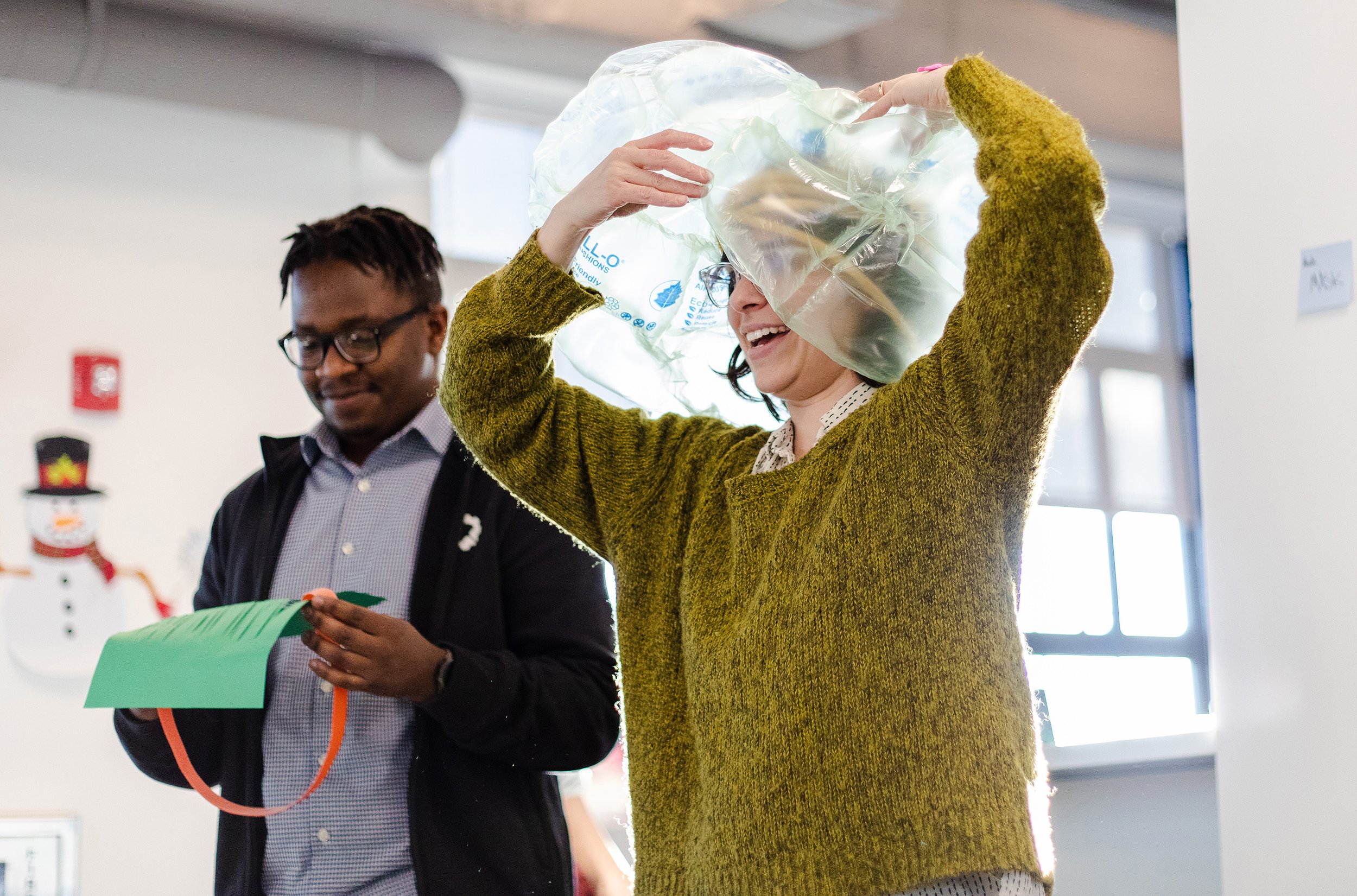2018 Ginkgo Creative Resident, Yasaman Sheri, in a Ginkgo Bioworks laboratory. Credit: Grace Chuang
A new technology is changing the world, turning dreams into reality, and promising solutions to some of our most intractable problems.
Industry wants to use it. Wall Street is investing in it. And governments around the world are paying attention. But with that excitement and recognition come questions of ethics, responsibility and unanticipated outcomes.
Is it crypto? Blockchain? Artificial intelligence? Social media?
No. This emerging technology is synthetic biology, a suite of disciplines that aims to make life science more like engineering, programming organisms to create new products and solve problems in energy, agriculture, medicine and manufacturing.
For the young companies pioneering the application of synthetic biology, it’s a heady and hopeful time. The possibilities for growth and civilization-level impact are enormous. But the unanticipated consequences of these new and powerful tools might also be equally far-reaching.
Ginkgo Bioworks laboratory. Credit: Ginkgo Bioworks
That’s why one of the leading players in this space, Ginkgo Bioworks, has invited artists and creators into their laboratories—to ask hard questions, raise uncomfortable issues, and help Ginkgo wrestle with the human effects of synthetic biology.
Ginkgo Creative Director Christina Agapakis and designer Natsai Audrey Chieza launched the Ginkgo Creative Residency in 2017 as a joint initiative of Ginkgo Bioworks and Chieza’s design agency Faber Futures.
As Chieza recalled, it came about when Agapakis inquired about purchasing one of Chieza’s bacteria-dyed textiles for Ginkgo headquarters. “I declined,” said Chieza, “because, in that moment, I thought we could do more together.” Instead, Cheiza suggested that Ginkgo put the money towards a residency, with her as the first resident. “I will be your willing guinea pig,” remembered Chieza telling Agapakis. Agapakis’s reply was immediate. “That sounds great. Let’s do it.”
2017 Ginkgo Creative Resident and Residency co-founder, Natsai Audrey Chieza, with her bacteria dyed textiles in the Ginkgo Bioworks laboratory. Credit: Ginkgo Bioworks
The Ginkgo Creative Residency welcomes creative professionals to Ginkgo headquarters in Boston for an annual three-month residency. Residents are paid a $5,000 monthly stipend plus a project budget, and they retain the intellectual property for works created in Ginkgo’s lab and with Ginkgo’s tools. “This defines the relationship we’re establishing with creative residents,” according to Chieza. “They should feel free to do their work without holding back.”
The six creatives who have already partnered with Ginkgo in the residency program defy easy stereotyping. They are writers, architects, photographers, futurists, designers, and interaction and interface specialists. Some have deep experience working with the tools of biology; others come to the laboratory as novices. And their projects at Ginkgo reflect this varied set of interests and backgrounds:
• The implications of creating at scale, and the way it changes the process, outcome, craft and tools of biology
• Envisioning wearable sensors, and the significance of human interaction in biodesign
• Exploring the process of decay and how to design a world without waste
• The role of skin in mediating interactions between organisms—a zone of “interspecies gossip”
• How language shapes synthetic biology, and the search for new meaning
“Every residency has been really different,” explained Joshua Dunn, Head of Design at Ginkgo and a mentor on the Ginkgo Creative Residency team. “I don’t think we’ve had anybody who would call themselves a professional artist. But it’s not just about art, it’s about the question-asking and the provocation.”
This focus on inquiry and being open to provocation is the essence of the Ginkgo Creative Residency. It helps ensure that the company’s mission of creating value through synthetic biology stays responsive to human needs and the good of society.
“How do you ask the right question to know that you’re making the world better? How do you bring other voices into the process of doing this kind of design?” said Agapakis. “It’s important for us to not just welcome, but truly engage with those critiques and ways of seeing and ask ourselves, ‘Is this the right way to go? How can we incorporate that point of view in the way that we approach a problem?’”
2019 Ginkgo Creative Resident, Andrea Ling, in Bioworks 1 at the Streptomyces work stations. Credit: Ally Schmaling
Andrea Ling, an architect, researcher and installation artist, was Ginkgo’s 2019 resident. Her project, “Design by Decay, Decay by Design,” was inspired by how nothing is ever discarded in nature. One organism’s waste is another’s food for growth. Material and energy go back into the system as a form of self-renewal.
“For the third residency call—on waste—we were more deliberate about what we were asking residents to engage with,” recalled Chieza. “Our aim was to help Ginkgo think strategically about zeitgeist issues like core sustainability in synthetic biology. That was not top of mind for people at the time.”
For Ling, the three-month residency only hinted at the possibilities of creating with biodegradation. As she wrote in her post-project summary, “Let us design waste as nature designs it, not just as the result of destruction and breakdown but rather as inputs for renewal and construction.”
2019 Ginkgo Creative Resident, Andrea Ling, in Bioworks 1, in the spore room, plating Aspergillus niger. Credit: Grace Chuang
“There’s a rich dialogue here about what we’re doing and its effects,” said Dunn. “That’s not just the effects of misuse of the technologies we’re building, but what are the effects of using it the correct way? I’m involved in this program so I can hear that kind of dialogue—and be a part of it as well.”
Why does this embrace of an outside perspective work at Ginkgo? According to Tom Knight, a co-founder of the company and leader in the world of computing before making a shift into life sciences, it comes down to how disciplines are linked together—in often unexpected ways.
“You can educate yourself in a very narrow sense with the goal of learning a specific subject and becoming adept at that subject. But the other goal is to learn how all these subjects are connected. I like to quote Mark Twain, ‘You don’t want to let your schooling get in the way of your education.’”
And, for Knight, that kind of broad curiosity, embedded in a company-wide culture, sets Ginkgo apart. “What is the most valuable asset that Ginkgo has? It’s not our intellectual property; it’s not our equipment. It’s the employees,” said Knight. “More than that, it’s who those people are and what their values are and what the culture of the company is. So it’s natural to want to amplify that culture and celebrate it with a creative residency. What concerns me the most about the company long-term is that we lose that culture. It’s the most important thing that we have.”
Ginkgo Bioworks Creative Director, Christina Agapakis, participating in a Ginkgo Creative Residency workshop. Credit: Grace Chuang
By bringing in creative residents—outsiders—who ask questions and explore issues that don’t get regular attention in a profit-driven environment, Ginkgo is finding a way to sustain that culture and strengthen it for the future.
“Artists have the imagination and openness to say, ‘What world do we want to live in together?’ That’s something I appreciate and value from working with artists,” said Agapakis, reflecting on the importance of the Ginkgo Creative Residency. “We know in our heart, those of us who’ve been around synthetic biology for a long time, that biology will be an important part of that new world and will change the way we live for good. It’s why creative collaborations matter. They give you the tools and the space to start imagining what could be.”
--
Published here on Forbes.com
May 19, 2022







